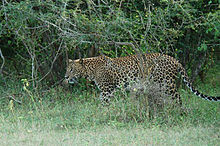Sri Lankan Leopard
| Sri Lankan Leopard | ||||||||||||
|---|---|---|---|---|---|---|---|---|---|---|---|---|

Sri Lankan Leopard in Wilpattu National Park |
||||||||||||
| Systematics | ||||||||||||
|
||||||||||||
| Scientific name | ||||||||||||
| Panthera pardus kotiya | ||||||||||||
| Deraniyagala , 1956 |
The Sri Lankan leopard ( Panthera pardus kotiya , formerly Ceylon leopard ) is a Sri Lankan subspecies of the leopard that was first described by the Sri Lankan zoologist PEP Deraniyagala in 1956.
The Sri Lankan leopard is classified as endangered by the IUCN .
Surname
The scientific name Panthera pardus kotiya is derived from the former Sinhala term for leopard ( kotiyā ). In Sri Lanka today, the word kotiyā is commonly used to denote tiger . Leopards are now known as diviyā .
The old name Ceylon leopard , which is derived from the earlier colonial name of Sri Lanka, is still often used . After independence, the state was renamed in 1972. Since then, the name Sri Lankan leopard has gained acceptance.
features
Compared to its relatives in other countries, the Sri Lankan leopard is usually built somewhat larger, which is attributed to a lack of food competitors, such as lions or tigers . The animal reaches a body length of about 110 to 150 cm and a shoulder height of up to 75 cm. The size varies relatively widely between males and females. The body weight of females is around 30 kg and of males 55 to 70 kg.
distribution
The Sri Lankan leopard is native only to the island of Sri Lanka. Due to its flexibility, it can be found in the tropical rainforest as well as in steppes and savannas.
It is believed that the island was still home to large numbers of leopards in the 19th century , as 8473 animals were officially killed between 1872 and 1899 alone. At the beginning of the 20th century , the number was estimated at 1660.
Especially in the country's national parks, such as Yala National Park or Wilpattu National Park , there are still quite a large number of leopards today. Current estimates assume a population of up to 600 wild animals. The reasons for the rapid decline in the population include the destruction of their habitat, such as through deforestation; an isolated, illegal hunt for leopard skin and the use of pesticides that accumulate in the food chain.
Only 58 specimens of this species are kept in zoological gardens and animal parks worldwide; the only animals in Germany are two specimens in the Hamm Zoo . The zoo makes every effort to participate in conservation breeding. A third animal died on March 18, 2011.
behavior
nutrition
The leopard uses a wide range of food in Sri Lanka. His prey animals include deer and primates, but also smaller ones, such as representatives of some reptile and bird species. Depending on the food supply, a single animal claims an area of around 50 km².
Reproduction
The Sri Lankan leopard reaches sexual maturity at around 24 to 30 months. Due to the solitary life of the leopards, the two sexes only come together in spring, their mating season in Sri Lanka. After a gestation period of 90 to 110 days, the young are raised by the mother. There are usually no more than two to three cubs in a litter.
Life expectancy is around 15 to 22 years, but in the wild it is considerably less at around 12 years.
Conflicts with people
The place of Punani in the eastern province of Sri Lanka achieved sad fame , where around 13 people fell victim to a man-eating leopard before the animal could finally be shot in 1924.
gallery
Web links
- Species profile of the Sri Lankan leopard; IUCN / SSC Cat Specialist Group in English
- Pictures and videos of the Sri Lankan leopard on arkive.org
- Panthera pardus ssp. kotiya inthe IUCN Red List of Threatened Species 2013.2. Listed by: Kittle, A. & Watson, A., 2008. Retrieved December 6, 2013.
Individual evidence
- ↑ Leopards (Panthera pardus). (No longer available online.) In: WWF -Artenlexikon. Archived from the original on April 29, 2016 ; Retrieved April 29, 2016 . Info: The archive link was inserted automatically and has not yet been checked. Please check the original and archive link according to the instructions and then remove this notice.
- ↑ Manrecap: The Leopard ( Memento of the original of July 14, 2006 in the Internet Archive ) Info: The archive link was automatically inserted and not yet checked. Please check the original and archive link according to the instructions and then remove this notice.
- ↑ Manrecap: The Leopard ( Memento of the original of July 14, 2006 in the Internet Archive ) Info: The archive link was automatically inserted and not yet checked. Please check the original and archive link according to the instructions and then remove this notice.
- ↑ www.tierpark-hamm.de: Sri-Lanka-Leopard ( Memento of the original from April 12, 2013 in the Internet Archive ) Info: The archive link was inserted automatically and has not yet been checked. Please check the original and archive link according to the instructions and then remove this notice.
- ↑ http://www.wa.de/nachrichten/hamm/stadt-hamm/leopard-tierpark-hamm-gestorben-1172652.html www.wa.de Leopard died in the Hamm Zoo
- ^ National Museum of Natural History




